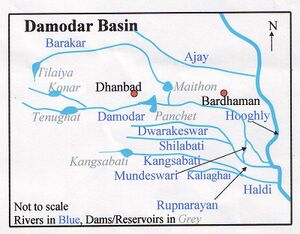Ajay River
| Author:Laxman Burdak, IFS (Retd.) |

Ajay River (अजय नदी) is a major river in Jharkhand and West Bengal. The Amystis of Greeks is modern-day Ajay River.[1]
Variants
- Ajamati (आजमती = अजय) (AS, p.14)
- Ajaya (अजय, प. बंगाल) (AS,p.15)
- Ajamavati (अजमावती)
- Amystis (Greek)
Origin of name
The word “Ajay” means “not conquered”
Course
The Ajay River originates on a small hill about 300 metres high, southwest of Munger in Bihar. It then flows through Jharkhand and enters West Bengal at Simjuri, near Chittaranjan. It first forms the border between Bardhaman District and Jharkhand and then between Bardhaman District and Birbhum District, and finally it enters Katwa subdivision of Bardhaman district at Nareng village in Ketugram police station. It then joins the Bhagirathi River at Katwa Town.[2]
अजय नदी
विजयेन्द्र कुमार माथुर[3] ने लेख किया है ...अजय नदी (AS, p.15) गीतगोविंद के विश्रुत कवि जयदेव के निवास-स्थान केंदुबिल्व या वर्तमान केंदुली के निकट बहने वाली नदी है।
अजय नदी जमुई ज़िले के 'चकाई' नामक स्थान से लगभग 5 किमी0 दक्षिण में 'बटपाड़' नामक स्थान से निकलती है। इसके बाद पूर्व एवं दक्षिण में प्रवाहित होती हुई पश्चिम बंगाल में प्रवेश करती है और गंगा में विलीन हो जाती है। इस नदी को 'अजमावती' या 'अजमती' के नाम से भी पुकारा जाता है। इस नदी पर कई स्थानों पर छोटे-छोटे बाँध बनाये गये हैं। इस नदी का उदगम क्षेत्र मुंगेर है, जहाँ से प्रवाहित होती हुई यह देवघर ज़िले के उत्तरी-पश्चिमी भाग में प्रवेश करती है। अजय नदी पश्चिम बंगाल, भारत की नदी है, और यह झारखण्ड में भी प्रवाहित होती है। यहाँ से यह नदी दक्षिण-पूर्वी दिशा में बढ़ती हुई प्रवाहित होती है। पश्चिम से आकर इसमें पथरी नदी मिल जाती है। आगे चलकर अजय नदी में जयन्ती नदी आ मिलती है। ये दोनों सहायक नदियाँ हज़ारीबाग़, गिरिडीह ज़िले से निकलती हैं। अजय नदी जामताड़ा ज़िले कजरा के पास प्रवेश करती है, जहाँ यह सीमा बनाती है।
संदर्भ: भारतकोश-अजय नदी
Tributaries
The important tributaries of the Ajay are Pathro and Jayanti in Jharkhand, and Tumuni and Kunur in Bardhaman district of West Bengal.[4]
The upper reaches of the Ajay pass through hilly regions with laterite soil. It is only from Ausgram in Bardhaman district that the Ajay flows through alluvial plains. The Ajay valley was densely forested with sal, piyasal and palas trees till recent times when mining and other activities led to the clearing of forests.[5]
History
In the history of ancient India edited by Mc Krindle, there was a river called Amystis that flows past a town called Katadupa, in the days of Megasthenes. Another historian Wilfred opines that Amystis is modern-day Ajay.[6]
Arrian[7] writes Amystis by the city Catadupas.
In recent times there has been exploration of the remains of an ancient civilisation similar to that of the Indus Valley Civilisation at Pandu Rajar Dhibi in the lower Ajay valley.[8]
There have been at least 14 recorded floods in the 20th century in the Ajay river. The lower reaches of the river have embankments to prevent flooding.
External links
References
- ↑ Roy, Jitendra. "The Deluge 2000" (PDF). Archived (PDF) from the original on 10 April 2009. Retrieved 2009-04-11.
- ↑ Chattopadhyay, Akkori, Bardhaman Jelar Itihas O Lok Sanskriti (History and Folk lore of Bardhaman District.), (Bengali), Vol I, p 27, Radical Impression. ISBN 81-85459-36-3
- ↑ Aitihasik Sthanavali by Vijayendra Kumar Mathur, p.15
- ↑ Chattopadhyay, Akkori, Bardhaman Jelar Itihas O Lok Sanskriti (History and Folk lore of Bardhaman District.), (Bengali), Vol I, p 27, Radical Impression. ISBN 81-85459-36-3
- ↑ Chattopadhyay, Akkori, Bardhaman Jelar Itihas O Lok Sanskriti (History and Folk lore of Bardhaman District.), (Bengali), Vol I, p 28, Radical Impression. ISBN 81-85459-36-3
- ↑ Roy, Jitendra. "The Deluge 2000" (PDF). Archived (PDF) from the original on 10 April 2009. Retrieved 2009-04-11.
- ↑ Arrian Anabasis Book/Indica 1, Ch.iv
- ↑ Chattopadhyay, Akkori, Bardhaman Jelar Itihas O Lok Sanskriti (History and Folk lore of Bardhaman District.), (Bengali), Vol I, p 28, Radical Impression. ISBN 81-85459-36-3
Back to Rivers

